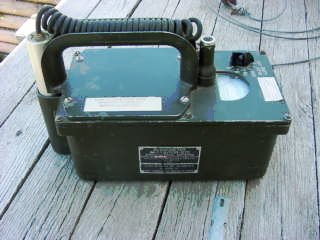
*AN-PDR 27 Survey meter*
By serger
19 May 2003
The USGI low range Beta, Gamma Survey meter

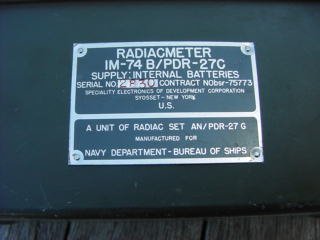
The AN-PDR27 meter has been a standard US military issue radiation survey meter or Radiac for the past 45 years. Radiac is an acronym for " Radiation, Detection, Identification, And Computation".
I used one in the propulsion plant while in the Navy on a routine basis. The first contracts for this meter were awarded in 1950 and the last ones about 1965-68. They were declared obsolescent in the late 1970ís and are still in use in some units because they never die. The AN-PDR27 series along with the IM-174 series meters have been replaced by the AN-VDR2. Specialty Electronics Development Corp who got their contract in 1957 made my particular "G" model. It weighs about ten pounds and is built like a tank. The down side of this meter was shown in the aftermath of Desert Storm. The troops were trying to clean up the mess of the depleted Uranium rounds the A-10 Warthog killed so many if the Iraqi tanks with. These meters didnítí have the sensitivity needed for the job. And that is well and good. They were designed for after the fact nuclear environment use and are slightly "coarse". But for that application they work well. The biggest problem was their lack of a directional probe. The "J" model of the series was the most common one on the civilian market in the middle of 2002. At the time of this writing (spring 2003) there are several venders selling surplus meter kits on the civilian military surplus market. All models of this meter utilize a dual Geiger Mueller (GM) Tube arrangement with the end window tube being the one that is used to detect Beta radiation on the lower 2 scales. These tubes are housed inside the probe. The 5979 GM tube is very rugged. Part of the reason for the longevity of the 5979 in this application is the tube is running at a de-rated voltage of 680 volts instead of the 900 volts it is rated. This practice of de-rating important equipment is common in military applications. In my case the ships generators on my ship were de-rated a full 25%. That was to allow for the "OH-NO" factor. In the case of the GM tubes it was a de-rating of 25% also.
.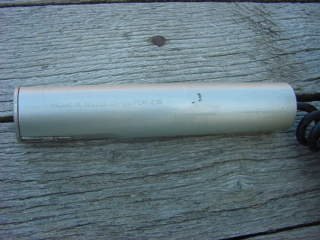
The probe is setup such that there is a shutter assembly at the end and to detect the presence of Beta radiation the "beta window" is opened
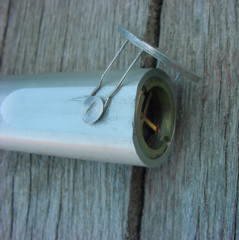
The different reading between the open window and the shut window is the amount of radioactivity that the beta emitter is adding to the background radiation. The internal GM tube is inside the probe and reads the higher two scales. Both tubes are powered up regardless of which scale you are reading from, the low range input is disabled when the 50 and 500mr ranges are being used. The meter has a selector switch and it has four meter settings along with a battery check. As you look at the photos below note that my batteries are dead. That was because the meter wasnít turned off after the last use. The pic on the right of that shows what a decent battery check looks like.
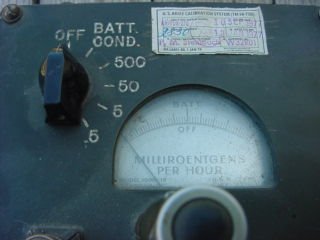
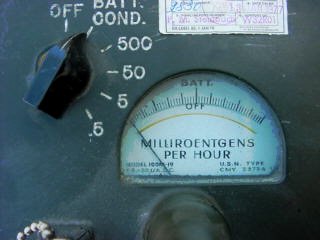
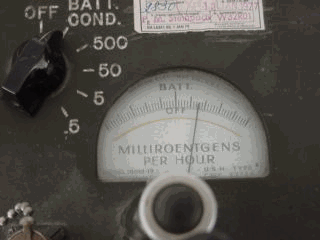
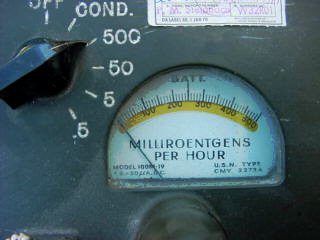
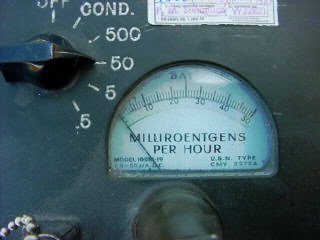
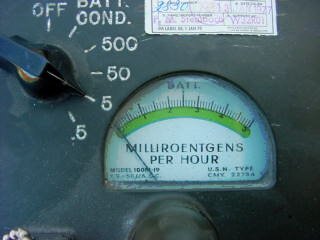
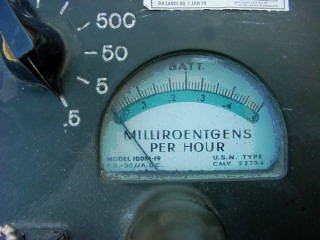
You will note the different scales are different colors. This is to serve as a mind jogger to "soldier proof" reading the meter. Also the meter scale selector is set to make you start your reading at the highest setting and work down. This is to protect the operator and the meter. Iíve heard, but cannot verify that having the wrong setting in the radiation field can damage the GM tube. I suspect the real reason is not to damage the analog meter by "pegging" it out.
Although the 27ís highest range monitoring is only in the 1/2r per hour range that is still a high enough range to exceed the yearly radioactive dose allowed for nuclear workers in slightly over ten hours exposure. In the real world it is used for site surveys of areas suspected of having been contaminated by particulate and to allow removal or stabilization of that particulate. We used it to "frisk" personnel leaving the reactor compartment and I suspect you would use it in the same application for persons returning to your shelter after an event to check that they were not bringing contaminated "stuff" into the safe areas.
Different models of this meter have different power supply requirements (SEE the picture below). On the "G" model there are three power supplies needed to power it up. They are in the form of three batteries. One is a 3-volt battery, one is 22.5 volts and one is 135 volts. When I got this meter, the gentleman I bought it from had it over a year and had decided to get rid of it because he couldnít get batteries for it. I took the meter and read the power plug label and made what I needed. One thing to note is the drawing of the BA-416/U shows connections that I donít have on this radiac. The military did that because it was easier for the supply system to have generic batteries that had similar applications and just pick off the voltages that they needed. In the case of this battery it had to power several varieties of the 27 and because of that there are several choices of voltages and the meter had the plug wired to accommodate the voltages it needed.
If you can manage to get Models "P" through "S" then that would be the best because those models run off 6 "D" cell batteries and that would require you to modify nothing.
.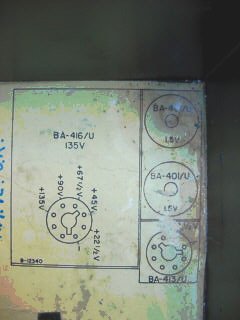
The battery well of the meter looks like the picture below when all the batteries I cobbled together are in it. If you want a small discussion on powering up surplus military equipment that utilizes weird batteries, go here. Itís nice to know how to make things "go" if you donít have quite the right parts.
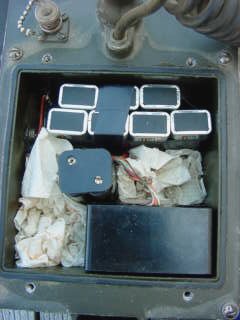
In of the picture below the135 volt battery is in the top with the 22.5 volt battery below it.
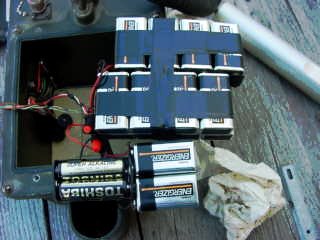
The 3-volt battery box required 2 spring loaded spacers to keep the "D" batteries in place. These I made out of sheet brass.
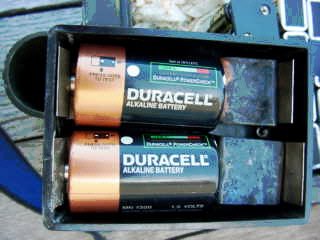
There are no user accessible components inside the main body of the meter itself. There are a couple of tubes, the main circuit board and a high voltage transformer. On the last of the series 27 meters the circuitry was solid state and that stuff is supposedly as good at resisting EMP as the tube meters were. If you remember when these meters were initially in production they were used to survey nuclear blast sites and many of them were subjected to the effects of blast and radiation exposure as part of the verification process that equipment of that time frame went through..
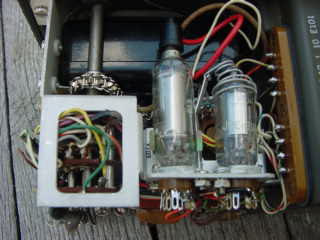
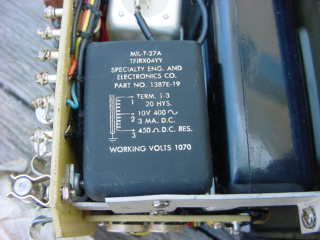
You can also access the potentiometers for the four meter ranges with the case off the unit.
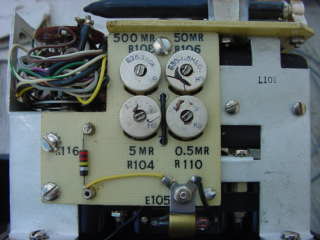
But in the real world the access point for these pots is a screw plug located on the meter case. Note the picture with the calibration potentiometers is upside down form where they would be inside the meter body. I did this so you could read what the circuit card said. You can see the potentiometer value on the mater case.
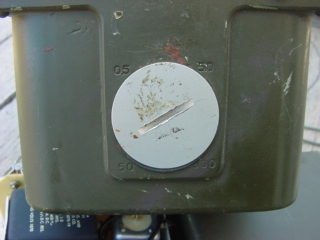
This meter has no high voltage adjustment capability to adjust the voltage to the GM tubes. The usual method was to replace the tubes when they aged enough to not calibrate when sent back to the depot. But due to the long life of the 5979 tubes this was usually not a problem over the life of the meter.
As the meter was fielded it had fairly potent check source in it. Those check sources were the MX-7338 that contained Krypton-85 and the MX-1083 that contained Radium-226. Part of the demilitarization process was to remove the check source. If the test set you have with your meter has the test source, good for you if not you need to obtain a check source that will at least tell you the meter is working. It will not tell you if the meter is within specification. I havenít found a good site on the net that verifies these meters so you might want to check with your local hospital or FEMA people to find a good place locally. Radmeters4u.com in Gonzales Texas might be able to do it but as of yet I havenít contacted them.
The meter has the provision for using a headset to detect radiation sources. The connection jack used is of the BNC type and I have the parts to do it but I havenít assembled a headset yet. We were told in the service the usual background count for the meter was 50 clicks per minute. This of course varies with the location of the user. In the hills around Moab Utah the background count would be higher than that of say Davenport Iowa. You need to take your meter out and find out what the "normal" count in your area is. One thing that you might not think about is the count will be higher in full sunshine than it will be in the shade.
National stock numbers for the meter I have been able to find are as follows:
6665-00-017-8903
6665-01-080-4418
6665-00-526-5334
6665-00-543-1443
6665-00-543-1435
6665-00-561-5887
6665-00-856-3456
6625-00-856-3466
6665-00-975-7222
The radioactive check sources used with the meter are as follows:
NSN: 6665-00-832-6159, MX-7338 RADIOACTIVE TEST SAMPLE CONTAINING KRYPTON-85
NSN: 6665-00-684-1199, MX-1083 RADIOACTIVE TEST SAMPLE CONTAINING RADIUM-226
I put this information out in the off chance you happen to find a peddler who has stuff listed by NSN or come across it at auction and not know what you are looking at.
Thanks for the read.
serger
All materials at this site not otherwise credited are Copyright (c) 1996-2003 Trip Williams. All rights reserved. May be reproduced for personal use only. Use of any material contained herein is subject to stated terms or written permission.